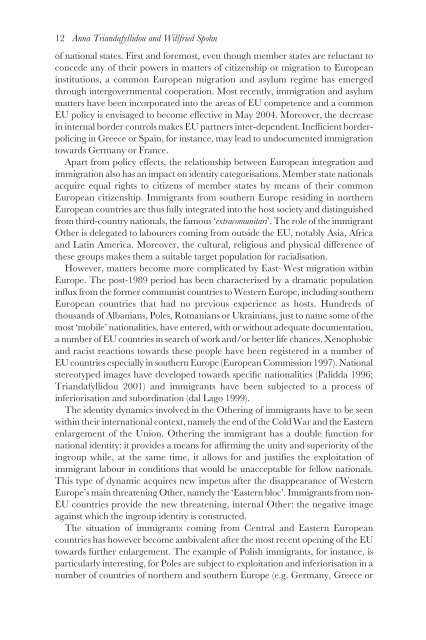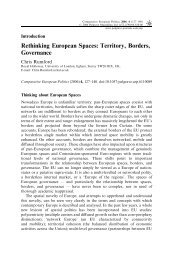Europeanisation, National Identities and Migration ... - europeanization
Europeanisation, National Identities and Migration ... - europeanization
Europeanisation, National Identities and Migration ... - europeanization
Create successful ePaper yourself
Turn your PDF publications into a flip-book with our unique Google optimized e-Paper software.
12 Anna Tri<strong>and</strong>afyllidou <strong>and</strong> Willfried Spohn<br />
of national states. First <strong>and</strong> foremost, even though member states are reluctant to<br />
concede any of their powers in matters of citizenship or migration to European<br />
institutions, a common European migration <strong>and</strong> asylum regime has emerged<br />
through intergovernmental cooperation. Most recently, immigration <strong>and</strong> asylum<br />
matters have been incorporated into the areas of EU competence <strong>and</strong> a common<br />
EU policy is envisaged to become effective in May 2004. Moreover, the decrease<br />
in internal border controls makes EU partners inter-dependent. Inefficient borderpolicing<br />
in Greece or Spain, for instance, may lead to undocumented immigration<br />
towards Germany or France.<br />
Apart from policy effects, the relationship between European integration <strong>and</strong><br />
immigration also has an impact on identity categorisations. Member state nationals<br />
acquire equal rights to citizens of member states by means of their common<br />
European citizenship. Immigrants from southern Europe residing in northern<br />
European countries are thus fully integrated into the host society <strong>and</strong> distinguished<br />
from third-country nationals, the famous ‘extracomunitari’. The role of the immigrant<br />
Other is delegated to labourers coming from outside the EU, notably Asia, Africa<br />
<strong>and</strong> Latin America. Moreover, the cultural, religious <strong>and</strong> physical difference of<br />
these groups makes them a suitable target population for racialisation.<br />
However, matters become more complicated by East–West migration within<br />
Europe. The post-1989 period has been characterised by a dramatic population<br />
influx from the former communist countries to Western Europe, including southern<br />
European countries that had no previous experience as hosts. Hundreds of<br />
thous<strong>and</strong>s of Albanians, Poles, Romanians or Ukrainians, just to name some of the<br />
most ‘mobile’ nationalities, have entered, with or without adequate documentation,<br />
a number of EU countries in search of work <strong>and</strong>/or better life chances. Xenophobic<br />
<strong>and</strong> racist reactions towards these people have been registered in a number of<br />
EU countries especially in southern Europe (European Commission 1997). <strong>National</strong><br />
stereotyped images have developed towards specific nationalities (Palidda 1996;<br />
Tri<strong>and</strong>afyllidou 2001) <strong>and</strong> immigrants have been subjected to a process of<br />
inferiorisation <strong>and</strong> subordination (dal Lago 1999).<br />
The identity dynamics involved in the Othering of immigrants have to be seen<br />
within their international context, namely the end of the Cold War <strong>and</strong> the Eastern<br />
enlargement of the Union. Othering the immigrant has a double function for<br />
national identity: it provides a means for affirming the unity <strong>and</strong> superiority of the<br />
ingroup while, at the same time, it allows for <strong>and</strong> justifies the exploitation of<br />
immigrant labour in conditions that would be unacceptable for fellow nationals.<br />
This type of dynamic acquires new impetus after the disappearance of Western<br />
Europe’s main threatening Other, namely the ‘Eastern bloc’. Immigrants from non-<br />
EU countries provide the new threatening, internal Other: the negative image<br />
against which the ingroup identity is constructed.<br />
The situation of immigrants coming from Central <strong>and</strong> Eastern European<br />
countries has however become ambivalent after the most recent opening of the EU<br />
towards further enlargement. The example of Polish immigrants, for instance, is<br />
particularly interesting, for Poles are subject to exploitation <strong>and</strong> inferiorisation in a<br />
number of countries of northern <strong>and</strong> southern Europe (e.g. Germany, Greece or



